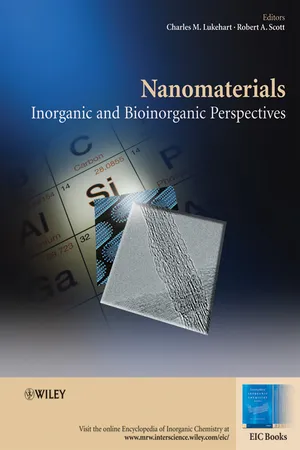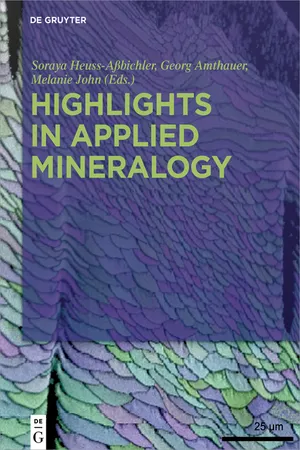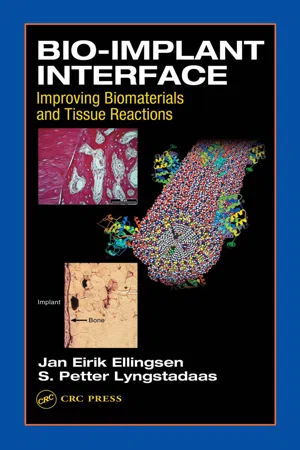Biological Sciences
Biomineralization
Biomineralization is the process by which living organisms produce minerals within their tissues. This process is essential for the formation of hard tissues such as bones, teeth, and shells in various organisms. Biomineralization involves the controlled deposition of minerals, often involving organic molecules that regulate the mineralization process.
Written by Perlego with AI-assistance
Related key terms
6 Key excerpts on "Biomineralization"
- eBook - ePub
Nanomaterials
Inorganic and Bioinorganic Perspectives
- Charles M. Lukehart, Robert A. Scott(Authors)
- 2013(Publication Date)
- Wiley(Publisher)
Biomineralization: Self-Assembly Processes Shu-Hong Yu and Shaofeng Chen University of Science and Technology of China, Hefei, People’s Republic of China1 INTRODUCTION
Biomineralization is a process by which living organisms deposit inorganic materials as skeletons, shells, teeth, etc. This process involves material deposition and structure formation of inorganic solids—known as biominerals —in a biological system.1 It is a very old process used by nature for over 500 million years in the development of life.2 Biominerals have complex structures exhibiting unique properties that have attracted much scientific interest. Biomineralization is often controlled precisely by the solubility properties of organic polymers in biological systems. Mineral crystallization and growth generally take place within confined spaces constructed by insoluble organic molecules or polymers. Many biominerals exhibit complex hierarchical structures built up as arrays of more fundamental building blocks of uniform size, shape, and crystalline polymorphism. Biominerals commonly crystallize with thermodynamically nonequilibrium shapes resulting from mineral deposition controlled by intricate interaction between functionally soluble polymers and an insoluble macromolecular matrix within an organism.1Soluble and insoluble organic molecules synergistically control the nucleation, growth, polymorphism, and orientation of biomineral deposition. For this reason, it is difficult to mimic the Biomineralization process and to distinguish the precise mechanistic roles played by these soluble and insoluble organic phases. The development of more sophisticated analytical methods has resulted in the separation, characterization, and sequencing of biopolymers active in Biomineralization; this has made it possible to gain greater insight into the role of biopolymers in the Biomineralization processes. In addition, a large number of synthetic polymers have been prepared, which have functional groups and structures similar to those of natural soluble or insoluble biopolymers. These synthetic polymers permit the study of biomimetic Biomineralization and help elucidate mechanistic features likely important in natural Biomineralization processes.3 –5 - eBook - ePub
Vitamin D
Two-Volume Set
- David Feldman, J. Wesley Pike, John S. Adams, David Feldman, J. Wesley Pike, John S. Adams(Authors)
- 2011(Publication Date)
- Academic Press(Publisher)
Chapter 21 MineralizationEve Donnelly and Adele L. Boskey, Hospital for Special Surgery, 535 E 70th Street, New York, NY 10021; affiliated with Weil College of Cornell Medical School, New York, NY 10021, USAIntroduction
Definitions
“Biologic mineralization” is the physicochemical process leading to deposition of inorganic crystals (minerals) on an organic matrix within the cell or outside it. This term is more specific than “mineralization,” as biologic mineralization implies a relation between the cells, the organic matrix, and the mineral. The cell-mediated Biomineralization process comprises oriented deposition of mineral within or adjacent to cells or upon an extracellular matrix. Examples of the former include iron oxides and sulfides in magnetotactic bacteria [1] and silicates in diatoms [2] ; examples of the latter include calcium carbonates in shells [3] and exoskeletons [4] and calcium phosphates in bones and teeth [5] .The mineral in physiologically calcified vertebrate tissues is an analog of the geologic mineral hydroxyapatite (Fig. 21.1 ). The physiologic hydroxyapatite crystals are 10–60 nm in their largest dimension [6] , much smaller than those found in geologic deposits, and have stoichiometries different from the predicted 10Ca:6P04 :20H of the geologic mineral. For that reason biologic vertebrate mineral is often referred to as “apatite” or “apatitic” meaning “like hydroxyapatite.” This chapter will focus on physiologic and dystrophic apatite formation in situ and in culture and on the effects of vitamin D on mineral formation.FIGURE 21.1 The hydroxyapatite unit cell showing the major substituents occurring in biologic apatites and the ions for which they substitute.Crystalline deposits may form by several different mechanisms. De novo crystal deposition occurs when the solution supersaturation exceeds the solubility of the precipitating phase. Supersaturation refers to the ratio of the solution ion product to the solubility product of the phase in question. The process starts with “nucleation” in which several ions or ion clusters come together in solution with the orientation they will have in the final crystal. This first step requires a great deal of energy, and is facilitated by increasing the ion product or reducing the diffusion of ions in solution [5] - eBook - ePub
Bioinorganic Chemistry -- Inorganic Elements in the Chemistry of Life
An Introduction and Guide
- Wolfgang Kaim, Brigitte Schwederski, Axel Klein(Authors)
- 2013(Publication Date)
- Wiley(Publisher)
The organic components in particular can have a “matrix” or “template” function with regard to vectorial (i.e. directly phase-dependent) crystal growth via specific catalysis and control of nucleation. Biological calcite, for example, usually does not form rhomboid crystals, as is the case for the unrestrained system, but is synthesized in functionally much more useful forms. In contrast to the “geological” minerals, biominerals also have to be formed and redissolved (“demineralized”) in a much shorter, biologically acceptable time period; therefore, relatively small crystalline domains or single crystals with large surface areas such as spicules are often formed, due to their better accessibility by the solvent. Nevertheless, the half-life of the calcium exchange in an adult human being amounts to several years, due to the relatively slow turnover in the solid-state skeleton. Pathological effects due to deviations from the normal metabolic rates for biominerals are quite common; these include calcium-containing deposits in blood vessels and the formation of calculi in the excretory organs (CaC 2 O 4, apatite, MgNH 4 PO 4), but also insufficient skeletal mineralization in children (rickets) and unwanted demineralization processes such as dental caries or bone resorption (osteoporosis) in the aging organism. Different degrees of Biomineralization can be distinguished, depending on the type and complexity of the already mentioned control mechanisms [3–5]. The most primitive type is biologically induced mineralization, which occurs mainly in bacteria and algae. In these cases, the biominerals are formed by spontaneous crystallization, via supersaturation through the action of ion pumps (see Section 13.4); polycrystalline aggregates with random orientations are then formed in the extracellular space. Gases formed in biological processes (e.g. by bacteria) frequently react with metal ions from the external medium to form such biomineral deposits - eBook - ePub
Bio-Nanomaterials
Designing Materials Inspired by Nature
- Wolfgang Pompe, Gerhard Rödel, Hans-Jürgen Weiss, Michael Mertig(Authors)
- 2013(Publication Date)
- Wiley-VCH(Publisher)
coupling of the biological structures with metabolic processes of living cells . This high complexity of Biomineralization is also the reason for its fascinating structural richness.When trying to analyze a complex problem, it is always useful to separate it, if possible, into partial problems that can be approached with simpler theoretical models. However, one has to keep in mind that understanding of the parts does not necessarily mean understanding of the whole.In the following, we will try to classify the mineralization processes into categories, depending on the impact of biomolecular structures on the product phase. Processes that mainly follow the classical chemical synthesis route go here under biologically mediated mineralization . If nucleation, final structure, shape, and size of the mineral depend mainly on biologically induced environmental conditions , we speak of biologically induced mineralization . This is the case when a biopolymer affects crystal growth, for example, by site-specific adsorption.Biologically induced mineralization usually concerns by-products of metabolic processes. If the mineral is unique in structure, shape, and size, the process is called biologically controlled mineralization . In this type of process, the mineral is the product of a reproducible biological synthesis with specific crystallochemical properties .Biologically induced mineralization and biologically controlled mineralization differ with respect to their result: Size, shape, structure, and composition of the mineral particles vary with the former, but are highly uniform with the latter. Biologically controlled mineralization produces structures of high complexity such as the distribution of calcium phosphate nanocrystals in bone or the calcium carbonate crystal distribution in mollusc shells. - eBook - ePub
- Soraya Heuss-Aßbichler, Georg Amthauer, Melanie John(Authors)
- 2017(Publication Date)
- De Gruyter(Publisher)
Biomineralization, biomimetics, and medical mineralogyPassage contains an image E. Griesshaber, X. Yin, A. Ziegler, K. Kelm, A. Checa, A. Eisenhauer and W.W. Schmahl
12Patterns of mineral organization in carbonate biological hard materials
12.1Introduction
Organization of nanosized entities across many length scales poses a major challenge in the development and production of man-made materials with advanced functions. In contrast, in biologically formed hard tissues, this design feature and its formation principle are intrinsic. It began already with the emergence of first skeletal hard parts in late Precambrian and was diversified since then by evolutionary adaptation.In this concept article, we describe nanoscale, mesoscale, and macroscale biocarbonate mineral organization in biological hard tissues such as shells, calcite teeth, and calcite intercalations into terrestrial isopod exocuticle. First, we highlight differences in extracellular matrix architectures and proceed to the interdigitation between biopolymer membranes/fibrils and biocarbonate mineral. Subsequently, we describe major types of fabrics and textures of mineral nanoparticles, crystallites and crystals in invertebrate hard tissues and discuss characteristic patterns of their organization on the different length scales.In the last part of this article, we illustrate the utilization of carbonate mineral organization (texture) by the animal as a tool for habitat-adapted tailoring and functionalization of hard tissues.12.2Composite nature of biological hard tissues
Mineralized structures generated under biological control are widely recognized in materials science as prototypes for advanced materials. These skeletal elements and teeth are hierarchical composites with a large variety of structural design concepts (e.g. [1 –7 , 8 - eBook - ePub
Bio-Implant Interface
Improving Biomaterials and Tissue Reactions
- J.E. Ellingsen, S.P. Lyngstadaas(Authors)
- 2003(Publication Date)
- CRC Press(Publisher)
Section IV Extracellular Matrix Biology and Biomineralization in Bone Formation and Implant Integration
Passage contains an image
13 Initiation and Modulation of Crystal Growth in Skeletal Tissues: Role of Extracellular Matrix
Colin Robinson, Roger C. Shore, Simon R. Wood, Steven J. Brookes, D. Alistair Smith, and Jennifer Kirkham
CONTENTS
13.1 Introduction13.1.1 Biphasic Development: The Organic Matrix13.1.2 Initiation of Crystal Deposition13.1.3 Modulation of Crystal Growth13.1.4 Initiation versus Inhibition13.2 Role of Organic Matrix13.2.1 Bone13.2.1.1 Collagen13.2.1.2 Bone Sialoprotein (BSP-2)13.2.1.3 Osteopontin (BSP-1)13.2.1.4 Bone Acidic Glycoprotein (BAG-75)13.2.2 Dentine13.2.2.1 Collagen13.2.2.2 Dentine Sialoprotein (DSP)13.2.2.3 Phosphophoryn (Dentine Phosphoprotein or DPP)13.2.2.4 Dentine Sialophosphoprotein13.2.3 Enamel13.2.3.1 Amelogenin13.2.3.2 Enamelin13.2.3.3 Possible Combined Role of Enamel Matrix Proteins13.3 SummaryReferences13.1 Introduction
Skeletal tissues comprise an inorganic mineral phase usually embedded in an extracellular organic, usually proteinaceous, matrix. Cells may be but are not always present within the tissue or at its periphery. The mineral phase is usually crystalline and in mammalian skeletal tissues, comprises a poorly crystallized, highly substituted calcium hydroxyapatite.The size, morphology, arrangement, and, to a large extent, chemistry of these hydroxyapatite crystals are related to the tissue in which they are formed, their locations within the tissue, and the stage of tissue development from which they derive. Enamel crystals are, for example, very large (~800 nm × 500 nm × 400 nm) compared with bone (~500 nm × 500 nm × 5 nm). Carbonate concentration in enamel ranges from ~2 to ~4%, whereas in bone it may range from 4 to 6%. Fluoride content is invariably higher in the crystals of the outer periphery of the tissues and in enamel; fluoride, carbonate, and magnesium levels are much higher in newly formed crystals than in those from later developmental stages.
Learn about this page
Index pages curate the most relevant extracts from our library of academic textbooks. They’ve been created using an in-house natural language model (NLM), each adding context and meaning to key research topics.





